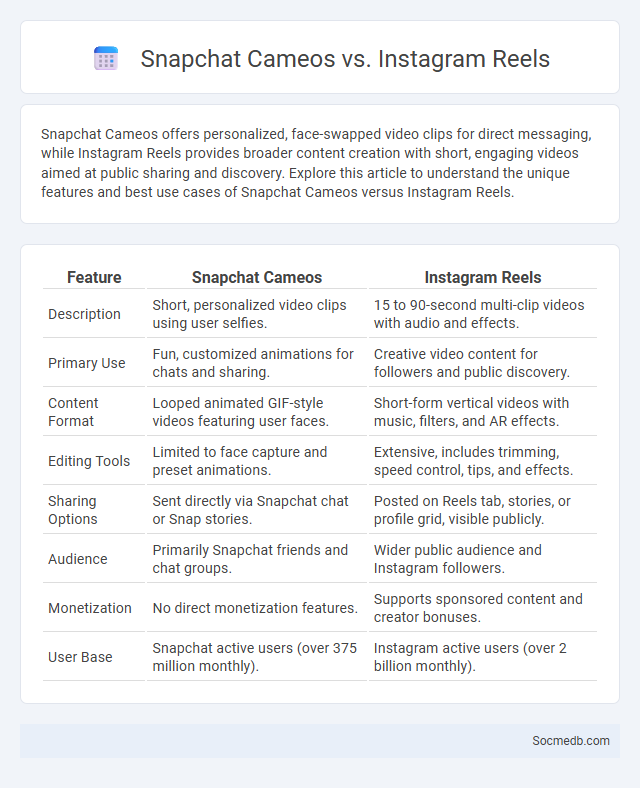
Photo illustration: Snapchat Cameos vs Instagram Reels
Snapchat Cameos offers personalized, face-swapped video clips for direct messaging, while Instagram Reels provides broader content creation with short, engaging videos aimed at public sharing and discovery. Explore this article to understand the unique features and best use cases of Snapchat Cameos versus Instagram Reels.
Table of Comparison
| Feature | Snapchat Cameos | Instagram Reels |
|---|---|---|
| Description | Short, personalized video clips using user selfies. | 15 to 90-second multi-clip videos with audio and effects. |
| Primary Use | Fun, customized animations for chats and sharing. | Creative video content for followers and public discovery. |
| Content Format | Looped animated GIF-style videos featuring user faces. | Short-form vertical videos with music, filters, and AR effects. |
| Editing Tools | Limited to face capture and preset animations. | Extensive, includes trimming, speed control, tips, and effects. |
| Sharing Options | Sent directly via Snapchat chat or Snap stories. | Posted on Reels tab, stories, or profile grid, visible publicly. |
| Audience | Primarily Snapchat friends and chat groups. | Wider public audience and Instagram followers. |
| Monetization | No direct monetization features. | Supports sponsored content and creator bonuses. |
| User Base | Snapchat active users (over 375 million monthly). | Instagram active users (over 2 billion monthly). |
What Are Snapchat Cameos, Instagram Reels, and Cameos?
Snapchat Cameos are animated short videos where users insert their faces into pre-made scenes for personalized messaging. Instagram Reels offer a platform for creating and sharing 15 to 90-second multi-clip videos with audio, effects, and new creative tools to engage audiences. Cameos combine AI facial recognition with user-generated content, allowing individuals to customize and animate their images within social media interactions.
Key Features Comparison: Snapchat Cameos vs Instagram Reels vs Cameos
Snapchat Cameos offers personalized short video clips using your facial expressions, creating interactive and humorous content tailored to you and your friends. Instagram Reels focuses on multi-clip videos up to 90 seconds, featuring extensive editing tools, audio integration, and a broad discovery platform to increase your reach. While both platforms emphasize creativity, Snapchat Cameos prioritize personal interaction through face-swapped animations, whereas Instagram Reels deliver versatile storytelling with rich multimedia capabilities.
User Experience: Ease of Use and Accessibility
Social media platforms prioritize user experience by designing intuitive interfaces that ensure ease of use across various devices, enhancing seamless navigation. Accessibility features such as screen reader compatibility, customizable text sizes, and voice commands empower users with disabilities to engage fully with content. Your engagement improves when social media platforms balance simplicity with inclusive design principles.
Creative Tools and Customization Options
Social media platforms offer a wide range of creative tools and customization options that empower you to produce unique and engaging content. Features like filters, stickers, video editing, and interactive polls allow for personalized storytelling tailored to your brand or personal style. Leveraging these tools enhances your online presence and fosters deeper connections with your audience.
Content Sharing and Audience Reach
Content sharing on social media platforms enables you to distribute videos, images, and articles rapidly to a vast audience, maximizing engagement and brand visibility. Effective content strategies leverage algorithms to target specific demographics, expanding audience reach exponentially. Consistent and relevant content encourages audience interaction, fostering community growth and boosting organic reach.
Privacy and Security Considerations
Social media platforms collect extensive user data, making privacy protection a critical concern for individuals and organizations alike. Implementing robust security measures such as end-to-end encryption, two-factor authentication, and regular software updates helps prevent unauthorized access and data breaches. Users should remain vigilant about privacy settings and limit sharing sensitive information to mitigate risks associated with identity theft and cyberattacks.
Monetization Opportunities for Creators
Monetization opportunities for creators on social media platforms include brand partnerships, sponsored content, and direct fan support through features like Super Chats and membership subscriptions. Platforms such as YouTube, Instagram, and TikTok offer revenue-sharing models, affiliate marketing, and in-app tipping to help you generate consistent income. Leveraging these tools strategically can maximize your earnings while building a loyal audience base.
Engagement Metrics: Likes, Shares, Comments
Engagement metrics such as likes, shares, and comments are essential indicators of how well your social media content resonates with your audience. Likes reflect immediate approval, shares expand your content's reach across networks, and comments provide valuable insights into audience sentiment and foster deeper community interaction. Monitoring these metrics allows you to tailor your strategy for improved visibility and meaningful connections.
Popularity and Trends Among Users
Social media platforms like Instagram, TikTok, and Twitter dominate user engagement due to their dynamic content and interactive features. Popularity trends reveal a shift towards short-form videos and live streaming, which keep users consistently connected and entertained. Your presence on these platforms can significantly impact brand visibility and personal networking opportunities.
Which Platform Suits Your Needs Best?
Selecting the right social media platform depends on your goals, target audience, and content type. Instagram excels for visually-driven brands seeking engagement through images and stories, while LinkedIn suits professionals aiming to build networks and share industry insights. You should evaluate audience demographics and platform features to determine which channel best supports your marketing strategy.
 socmedb.com
socmedb.com